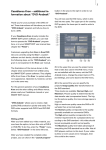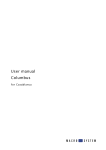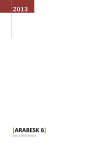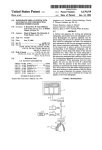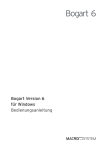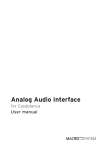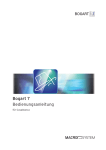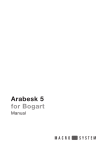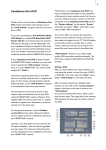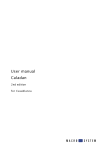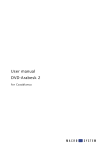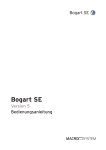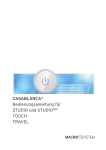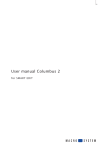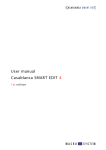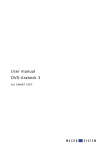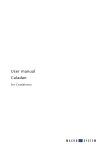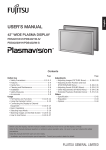Download Arabesk 6 User manual
Transcript
Arabesk Version 6 Manual Legal Information The information in this document is subject to change without notice and does not represent a commitment on the part of MacroMotion GmbH. No part of this manual may be copied, reproduced or otherwise transmitted, in any form, for any purpose, without prior express written permission by MacroMotion GmbH. All product and company names are trademarks of their respective owners. We recommend that you carefully read the information in this manual, in order to avoid operator errors. We have taken great care in developing and testing this program. Since it is currently not possible to guarantee error-free operation under all circumstances and at all times, we can unfortunately not entirely exclude that some errors may have crept in. Hence, MacroMotion GmbH and its distributors do not guarantee a problem-free or completely error-free operation of the product. With respect to any warranty, liability and damage claims, the provisions of the terms and conditions of MacroMotion GmbH shall apply. We cannot accept any liability for loss of data/time or any consequential damages that may occur as a result, particularly since we have no influence over correct software installation and operation by the customer. MacroMotion GmbH and its dealers therefore cannot be held liable for any defects or unintentional damage in connection with the installation or use of the program Arabesk 6. Claims for damages and compensation, regardless of the legal basis, in particular due to breach of duties in connection with obligation or tortuous acts are therefore excluded. This shall not apply in the case of mandatory liability, e.g. under the German Product Liability Act (Produkthaftungsgesetz), in the case of intent, gross negligence, injury of life, body or health, or breach of essential contractual obligations. Damage compensation entitlement for breach of essential contractual obligations is, however, limited to the foreseeable damage typical of the contract, unless there is willful intent or gross negligence or in case of injury to life, body or health. The provisions above do not imply a change of the burden of proof to the detriment of the purchaser. Neither MacroMotion GmbH nor its dealers are responsible for any damages resulting either directly or indirectly through the use of the software or the operating instructions. This applies in particular to loss of profits and compensation for expenses. Any implied guarantee is excluded, including guarantee of suitability of the software or operating instructions for a particular purpose. For this reason, you should make a backup of your video footage before you start using the device. We recommend that you do not delete the video footage and that you create a backup copy beforehand. Since it is possible that changes were made to the software after the manual was prepared, the functions shown and described in this manual might differ from the software. Arabesk 6 User manual 3 Table of contents 1. General information . . . . . . . . . . . . . . . . . . . . . . . . . . . . . . . . . . . . . . . . . . . . . . . . . . . . . . . . . . . . . . . . . . . . . . . . 4 1.1 Congratulations! . . . . . . . . . . . . . . . . . . . . . . . . . . . . . . . . . . . . . . . . . . . . . . . . . . . . . . . . . . . . . . . . . . . . . 4 1.2 Installation . . . . . . . . . . . . . . . . . . . . . . . . . . . . . . . . . . . . . . . . . . . . . . . . . . . . . . . . . . . . . . . . . . . . . . . . . . 4 1.3 Starting Arabesk 6 . . . . . . . . . . . . . . . . . . . . . . . . . . . . . . . . . . . . . . . . . . . . . . . . . . . . . . . . . . . . . . . . . . . . 4 1.4 What is Arabesk 6 . . . . . . . . . . . . . . . . . . . . . . . . . . . . . . . . . . . . . . . . . . . . . . . . . . . . . . . . . . . . . . . . . . . . 4 1.5 What is new in Arabesk 6 . . . . . . . . . . . . . . . . . . . . . . . . . . . . . . . . . . . . . . . . . . . . . . . . . . . . . . . . . . . . . . 4 1.6 The Basic, Silver, and Gold Editions . . . . . . . . . . . . . . . . . . . . . . . . . . . . . . . . . . . . . . . . . . . . . . . . . . . . . . 5 2. Reference section . . . . . . . . . . . . . . . . . . . . . . . . . . . . . . . . . . . . . . . . . . . . . . . . . . . . . . . . . . . . . . . . . . . . . . . . . 7 2.1 Clarity is very important for the main menu . . . . . . . . . . . . . . . . . . . . . . . . . . . . . . . . . . . . . . . . . . . . . . . . 7 2.2 Environment – It's all about settings . . . . . . . . . . . . . . . . . . . . . . . . . . . . . . . . . . . . . . . . . . . . . . . . . . . . . . 7 2.2.1 Assistant . . . . . . . . . . . . . . . . . . . . . . . . . . . . . . . . . . . . . . . . . . . . . . . . . . . . . . . . . . . . . . . . . . . . 7 2.2.2 Disc projects . . . . . . . . . . . . . . . . . . . . . . . . . . . . . . . . . . . . . . . . . . . . . . . . . . . . . . . . . . . . . . . . 10 2.2.3 Settings . . . . . . . . . . . . . . . . . . . . . . . . . . . . . . . . . . . . . . . . . . . . . . . . . . . . . . . . . . . . . . . . . . . . 11 2.2.4 Miscellaneous . . . . . . . . . . . . . . . . . . . . . . . . . . . . . . . . . . . . . . . . . . . . . . . . . . . . . . . . . . . . . . . 12 2.3 Preparing – A good preparation is everything . . . . . . . . . . . . . . . . . . . . . . . . . . . . . . . . . . . . . . . . . . . . . . 12 2.3.1 Movies . . . . . . . . . . . . . . . . . . . . . . . . . . . . . . . . . . . . . . . . . . . . . . . . . . . . . . . . . . . . . . . . . . . . . 12 2.3.2 Chapters . . . . . . . . . . . . . . . . . . . . . . . . . . . . . . . . . . . . . . . . . . . . . . . . . . . . . . . . . . . . . . . . . . . 13 2.4 Creating – be creative . . . . . . . . . . . . . . . . . . . . . . . . . . . . . . . . . . . . . . . . . . . . . . . . . . . . . . . . . . . . . . . . 14 2.4.1 Menu templates . . . . . . . . . . . . . . . . . . . . . . . . . . . . . . . . . . . . . . . . . . . . . . . . . . . . . . . . . . . . . 14 2.4.2 Main and chapter menu . . . . . . . . . . . . . . . . . . . . . . . . . . . . . . . . . . . . . . . . . . . . . . . . . . . . . . . 15 2.4.2.1 Designing menus with the design window . . . . . . . . . . . . . . . . . . . . . . . . . . . . . . . . . . 15 2.4.2.2 Designing menus with the toolbar . . . . . . . . . . . . . . . . . . . . . . . . . . . . . . . . . . . . . . . . 16 2.4.2.3 Control (Main menu) . . . . . . . . . . . . . . . . . . . . . . . . . . . . . . . . . . . . . . . . . . . . . . . . . . . 17 2.5 Finish – Last but not least . . . . . . . . . . . . . . . . . . . . . . . . . . . . . . . . . . . . . . . . . . . . . . . . . . . . . . . . . . . . . 21 2.5.1 Quality . . . . . . . . . . . . . . . . . . . . . . . . . . . . . . . . . . . . . . . . . . . . . . . . . . . . . . . . . . . . . . . . . . . . . 21 2.5.2 Preview . . . . . . . . . . . . . . . . . . . . . . . . . . . . . . . . . . . . . . . . . . . . . . . . . . . . . . . . . . . . . . . . . . . . 22 2.5.3 Burn disc . . . . . . . . . . . . . . . . . . . . . . . . . . . . . . . . . . . . . . . . . . . . . . . . . . . . . . . . . . . . . . . . . . . 22 2.5.4 Export disc . . . . . . . . . . . . . . . . . . . . . . . . . . . . . . . . . . . . . . . . . . . . . . . . . . . . . . . . . . . . . . . . . 23 3. The info box – everything at a glance . . . . . . . . . . . . . . . . . . . . . . . . . . . . . . . . . . . . . . . . . . . . . . . . . . . . . . . . . 23 4. Arabesk and Power Key option – does it work? . . . . . . . . . . . . . . . . . . . . . . . . . . . . . . . . . . . . . . . . . . . . . . . . 25 5. Quick guide: How do I create a disc manually? . . . . . . . . . . . . . . . . . . . . . . . . . . . . . . . . . . . . . . . . . . . . . . . . 25 4 1. General information 1.1 Congratulations! Congratulations on the purchase of the software Arabesk 6. We thank you for your confidence and trust you have shown us, and we hope that the product will meet your expectations. This manual will explain the steps necessary to burn a DVD or a Blu-ray. The manual is for all Casablanca users working with Bogart SE. Feel free to contact us if you have additional questions or to give us suggestions for improving the product. Please contact us at the address below. Whenever you contact us, please have your customer number or the serial number of your device at hand so that we can help you more quickly. MacroMotion GmbH Werftstraße 193, 24143 Kiel, Germany E-mail: [email protected] Up-to-date information on MacroSystem products can be found on the Internet: www.macrosystem.de (Germany) www.macrosystem.us (North America) If you have specific technical queries, please contact your local dealer. You may also visit our Internet Support Forum: www.macrosystem.de/forum. In the forum, you will be able to find assistance, step-by-step directions, and tips and tricks for MacroSystem hardware and software products. 1.2 Installation In order to install Arabesk 6 on your Casablanca device, it must be equipped with at least 1 GB RAM as well as Bogart SE 4.5c or higher. Arabesk 6 can be fully used from Bogart SE 5 onwards. To install Arabesk 6, please insert the appropriate software CD/DVD in the drive of your device. You should now go to the Settings menu item in Settings. You should then click on the System button, followed by the ‘Install product’ button. This will open the ‘Install Product’ dialog window (the hour glass may be displayed instead of the mouse pointer for a short time, until the inserted CD/DVD has been read). It has a list with the products that are already installed on your system as well as the products included on the inserted CD/DVD. Arabesk 6 can also be found here. Select Arabesk 6 and click on activate. The installation starts, as can be seen from a progress bar. A short while later, a number block appears. This is used to enter the activation code you received from your dealer. The product will then be active. Tip: While Arabesk 6 is being installed, you may hear noise from the drive. Arabesk 6 cannot be installed as a demo version. If you install Arabesk 6 without activating it, you will not be able to start Arabesk 6, and when you try, you will get a message to tell you as much. 1.3 Starting Arabesk 6 To start the Arabesk 6 program, you should go to the main menu of Bogart SE. When Arabesk 6 has been installed, you will find an Arabesk button in the Finish menu. You start the Arabesk 6 program, by clicking on this button with the left trackball button. 1.4 What is Arabesk 6? Arabesk 6 is an add-on product from our company that enables you to burn your projects to CD, DVD or Blu-ray, or to save them as ISO images on USB or SATA storage media. Depending on the Bogart SE Edition (Basic, Silver or Gold), you may work at up to 10 disc projects at the same time, in which you can partition your movies in chapters to make them directly accessible during play, burn several movies on a single disk, also in different quality levels, or create main and chapters menus for your discs. A multitude of possibilities and templates is at your disposal to create your disc menus. With Arabesk 6, you may also create animated disc menus as well as multi-angle discs (discs with movie(s) that have been recorded from several viewing angles). In addition, you also have the possibility to verify your work before burning a disc, thanks to the preview function. 1.5 What is new in Arabesk 6? (if you are upgrading from Arabesk 5) The user interface of Arabesk 6 has been completely reworked and redesigned to make it clearer. We thought it was important to make it easier to operate the program and introduced a type of check system for the creation of discs. It is now also possible to create animated main and/or chapter menus for Blu-ray discs, optionally with sound, with a duration of up to 5 minutes, and to create several disc menus in parallel, without losing the previous main or chapter menus. Besides this, there is a whole slew of smaller innovations that are discussed in this manual. Arabesk 6 User manual 5 1.6 Basic, Silver and Gold Edition What is the functionality of… The different versions of the Bogart SE operating system also offer you different possibilities to design your discs in Arabesk. With the Basic Edition you can create your discs via the Assistant, as well as make settings for the burning speed, play a burned DVD, delete a CD-RW or DVD-RW and reset Arabesk 6 to its factory settings. With the Silver Edition and Arabesk 6, it is also possible to create custom designs for your discs without using the Assistant. Creating chapter menus as well as working on several disc projects is only possible with the Gold Edition. Other differences between the editions are pointed out in the appropriate sections. 6 Arabesk 6 User manual 7 2. Reference 2.2 Environment – It's all about settings 2.1 Clarity is very important for the main menu In the Environment menu, you have the option of letting our Assistant guide you through the creation of a menu (more about the Assistant in the corresponding chapter). Here, you will also find the project management of the different disc projects you are able to work on in parallel with Arabesk 6, as well as settings you can make across the board, i.e. with respect to all disc projects. Information about drive and storage medium can also be accessed here. If several drives are connected, you will be able to access information about every drive and you will have the ability to select the desired drive. 2.2.1 Assistant The main menu of Arabesk 6 has been reorganized and is now similar to the main menu of Bogart SE. The individual menu items are now grouped under 4 parent menu items, namely Environment, Prepare, Shaping and Finish. This order corresponds to the usual sequence of editing steps. In the title bar of the menu, one sees no longer just the name of Arabesk 6, but also the currently selected resolution, such as SD for the Video DVD target format. The target format that was not selected, is more pale. A short while after you hold the mouse pointer on the resolution indicator, a help text will appear to indicate the currently selected resolution or target format. When you click with the left trackball button on the resolution, you will have the option to change the target format and therefore also the resolution. If the RenderBooster is inserted and recognized, this will be indicated in the title bar, to the left of the resolution. If the RenderBooster is inserted, but not active, its indicator will be paler and in brackets. If the RenderBooster is active, the indicator will become white and the brackets will disappear. When you want to use the RenderBooster, go in Arabesk 6 under Environment to Settings and place a checkmark next to ‘Use RenderBooster’. (for example, in the picture above, the RenderBooster is being used and HD (Blu-ray) has been selected as the target format) On the right, there is a preview window with the current view of the main menu for the selected disc project. In the bottom part of the screen, there is an info box that shows you the current status of the disc project at a glance. Please refer to the "The info box – everything at a glance" chapter for more information. There is, of course, a button to open and close the drive, and also a button , to return to the Bogart SE main menu. If your device has two drives or if you have connected a second, external, drive to your device, you will be asked which drive should be opened before the drive will open. When you use the assistant, it will conveniently guide you through all editing necessary or optional steps for creating a disc. At each editing step, there is the possibility to go to the next editing step by clicking on Next or to return to the previous editing step by clicking on Back. If a choice is required in an editing step in order to burn a movie on a disc, the Next button will only become active when the corresponding setting has been made. In case you are not using the assistant, click on the Cancel button to return to the Arabesk 6 main menu. After clicking on the Cancel button, a confirmation prompt will open to confirm that you do indeed wish to end the assistant and reject the settings you have made so far. The Yes button will end the assistant, whereas the No button will take you back to the last editing step you performed with the assistant. This prompt will appear every time you click the Cancel button, regardless of the editing step of the assistant that is currently active. When the assistant starts, a dialog box will allow you to select the format you want to use for your disc, Video DVD or Blu-ray. Click on the corresponding button in the dialog box to make your choice. Once you have selected the target format of your disc, you will be able to use the ‘Select film’ button to select the project you want to burn on your disc. 8 set chapter marks, you may choose between ‘Every 5 minutes’ and ‘Every 10 minutes’. Tip: If a movie is shorter than five minutes or if you do not have the Silver or Gold Edition, the assistant will not allow you to set chapters and this option will be omitted. When you have selected your project, it will appear in a selectable text field in the dialog window (in the picture below, this field contains ‘Vacation 2012’. If you have set chapter marks, the following editing step will allow you to use a checkmark to determine if you want to set a chapter menu for the disc and what names the individual scenes should get. Click on this field to change the name of the project which will later be shown in the main menu of the disc, next to the button for the corresponding movie. To this end, the familiar ‘Input text’ dialog box will appear. The Quality editing step allows you to select between the following quality levels: Low, Medium, High and ‘Very high’ (the ‘Very high’ quality level is only available in the Gold Edition). In order to determine the expected storage capacity needed for the disc, you will also be able to select the reference storage medium using the corresponding selection button. The editing step ‘Chapters’ is used to define chapter marks by setting a checkmark. Should you not wish to set chapter marks, just leave the checkmark at ‘None’. Should you wish to A choice can be made between the names of the corresponding scenes or a sequential numbering of the chapters. In case you wish to create a chapter menu and you have set the checkmark accordingly next to Yes, the ‘Choose template’ button will also become active, as well as the buttons to name the chapters. Click on the ‘Choose template’ button to open a new dialog window, ‘Load menu template...’, in which you will be able to select a template for the chapter menu. The chapter menu selected in the list is also displayed in a preview window at the right-hand side of the ‘Load menu template...’ dialog window. Confirm your selection with the OK button. You will now be returned to the assistant and be able to continue editing your disc. Arabesk 6 User manual 9 Tip: A chapter menu can only be created using the predefined templates. The next dialog window will allow you to create a button for the previously added movie, to represent it in the main menu of the disc. Click on the ‘Select scene image’ button to do this. You will now get to the menu for selecting button patterns, and will be able to select the scene containing the desired pattern and then confirm the selection by clicking on OK. Should you want to add another project, simply click on the button ‘Choose another film’. When you have selected an additional movie, it will appear together with the project name in a text box in the dialog window. Click on this field to change the name of the project or the movie which will later be shown in the main menu of the disc, next to the button for the corresponding movie. When you click the Continue button after adding another movie in this editing step, you will be taken to the Quality editing step again which will allow you to select the appropriate settings for the movie you just added. After this, you will also be able to set chapter markers, to create a chapter menu, to create a menu button for the movie in the main menu of the disc and to add additional movies. If you did not add another movie and you click on the Continue button, the next editing step will allow you to set a checkmark to indicate if the main menu must first be shown after the disc has been inserted in a player, or if the first movie should start to play immediately. You will now be able to select a pattern from the scene you have selected, by clicking on the Position button and then rolling through the scene using the trackball. Once you have made your choice, click on the Continue button to go to the next editing step of the assistant. You are now in the ‘Menu creation’ editing step. Once you arrived at the desired spot in the scene, click the left button of your trackball. Should you wish to make a more precise choice, you should use the and buttons in order to advance or go back frame by frame in the movie, until the pattern you wish to use for the button has appeared. Click now on the OK button to confirm your selection and return to the assistant. In the next step, the assistant will ask you if you want to burn an additional project (i.e. another movie) on the disc. If that is not the case, the Next button will take you to the next editing step. Here, you will be able to use the ‘Select template’ button to create your main menu. Clicking on this button will open the ‘Load menu template...’ dialog window. Also here, there are numerous templates from Arabesk 6 at your disposal, as well as menu templates that you have created yourself which you have already saved. 10 made by the assistant will be preserved and can now be adjusted individually. 2.2.2 Disc projects Once you have selected one of these templates, you should confirm your selection with the OK button to return to the editing step. The next editing step, ‘Menu design – Background’, offers you several options to create a background for your main menu. Place a checkmark next to the desired option. If you select the options Pattern, ‘Image from scene’ or ‘Moving scene (with sound)’, the ‘Select pattern/scene’ button will also become active, and using this button will take you to the corresponding dialog window in order to add the desired pattern or the desired scene/scene image as a background to the main menu. When you have done this, the Continue button will take you to the last editing step of the assistant. This will allow you to set a checkmark to indicate if the disc should be burned right away or if you prefer to switch to the manual editing mode of Arabesk 6 (possible from the Bogart SE Silver Edition onwards). If you have selected the ‘Burn Disc’ option and you click on the Continue button, you will be asked to insert a writable disc in the drive of your device, if this has not yet been done. Apart from that, the device will now start with its calculations and burn the disc. If you have selected the ‘Edit Disc with Arabesk’ option, you will be returned to the main menu of Arabesk 6. The settings With Arabesk 6, you have the possibility to work on up to 10 disc projects in parallel and independently from each other. However, this is only so for users of the Bogart SE Gold Edition. The ‘Disc Projects’ menu is used to manage these individual disc projects. Tip: The disc projects are only available within Arabesk. These are not Bogart SE projects. Select: Use the Select button to select a disc project for editing your disc, in the same way you already know from the Bogart SE project selection. You can of course also give the disc project its own individual name, by clicking on the text field next to the Select button. Target format: The format in which you want to burn your movie can be set with the ‘Target format’ button. The target format for your disc can be selected in the corresponding dialog window by setting a checkmark. When you switch the target format, a message will appear asking you if you want the change the target format. If you want this, confirm the dialog window with Yes. If not, click No. When you change the target format, the display in the main menu of Arabesk will be adjusted accordingly. Tip: The target format is not the storage medium (CD, DVD or BD) on which your movie is to be burned, but the format in which the movie is to be burned to a disc. We recommend you use a storage medium that officially matches the target format (DVD/DVD DL for Video DVD and Blu-ray 25/50 GB for Blu-ray). Other combinations are possible, but may lead to problems when playing the disc. Copy: Menus or disc projects you created can also be copied and used for other movies that have to be burned to a disc. When you click on the Copy button, this will open a dialog window with the currently empty disc projects. There, you will be able to select in which disc project you want to store a copy of the currently active disc project. Arabesk 6 User manual 11 Remove: Click this button to delete the currently active disc project. The system will ask you whether the entire disc project or only the calculated data should be deleted. Set a checkmark next to the desired option and click OK to proceed with the deletion. Below, you will find the possible looks of the button. Button symbol Selected medium CD DVD Tip: Large disc projects sometimes take lots of space on your hard disc (up to 50 GByte). When space becomes tight, you can delete ‘calculated data’ without changing the disc project itself. The data will then be recreated later on when this becomes necessary. Read disc: Click on this button to call up the ‘Read Disc’ dialog window. Use the selection button ‘Read from’ to select the data type you want to read. You can select between Disc, for a conventional ‘Video DVD’ burned with Arabesk, and ‘ISO Image’ for ISO images that were created with ‘Export Disc’ in Arabesk 6. When you have set an appropriate data type, clicking on the ‘Start reading’ button will allow you to import the disc in the currently active disc project. If the currently active disc project is not empty, a corresponding message will appear which you will be able to confirm with Yes to continue with the import or close with No to cancel the import. If you have not inserted a storage medium yet, you will be asked to insert a storage medium. Confirm with OK when you are finished. Information: This provides you with information about the active disc project. At the top of the dialog field, you can see which disc project is currently active. Below this, you'll find the number of inserted movies, the total duration of all movies and the disc capacity in use of the currently selected reference medium in the form of bars and as a percentage. DVD DL Blu-ray 25 GB Blu-ray 50 GB Clicking on this button will open the ‘Select reference media’ dialog field. Put a checkmark next to the desired storage medium to select it. The dialog field after the medium will also indicate what the currently used capacity on this medium is or will be with the active disc project. The button to change the reference medium can be found in different menu items and can be used at any time to change the reference medium within Arabesk 6. Tip: In the next chapters, the button will be displayed with the DVD symbol, most of the time. 2.2.3 Settings To the right of these indicators, there is a button with which you can switch to an additional dialog field in which you will be able to select the reference storage medium (CD, DVD,…). Make your selection by putting a checkmark after the storage medium you which to use. Tip: These actions only concern the settings made in Arabesk, as well as main and chapter menus of the selected disc project, not the corresponding movies in Bogart SE. CD, DVD or Blu-ray? - The choice is yours The storage medium on which you will burn your disc project, is only determined by the disc which inserted when burning. In order to see the anticipated used capacity, you can and should select beforehand the storage medium you are likely to use. There is a specific button for this in Arabesk 6, that is displayed differently in function of the currently selected medium. Use this to make general settings for all disc projects. Put a checkmark next to the options you want to use. This way, you may select the RenderBooster for calculating the disc, whether there should be more frequent confirmation prompts, whether DVDs should be verified after burning, and whether the device should switch off itself when the disc has been burned. The burning speed is also set here, between 1x – 18x. Alternatively, the option ‘Auto’ (automatic) can be selected. If this 12 setting is selected, the burning speed will automatically be adjusted for the blank disc that has been inserted. 2.3 Preparing – A good preparation is everything Tip: As a rule, ‘auto’ should always be selected here. Only when certain discs cause problems, should a burning speed be set manually. 2.3.1 Movies You also have the possibility to use the ‘Reset to factory defaults’ button to restore your Arabesk product to its original settings. Additionally, the menu templates you have created yourself can also be deleted. CAUTION, after confirming the confirmation prompt with OK, you will lose all disc projects in Arabesk, not only the current one. Bogart SE projects will remain unchanged. You will normally never need this option. It should only be helpful in case of technical problems. If you have a system with two drives, such as a Casablanca Karat, you will also have the option ‘Use two drives’ which you will be able to select by putting a checkmark next to it. This option will also appear when you are using an additional external drive. Tip: The changes in this menu will affect all disc projects. 2.2.4 Miscellaneous Under this menu item, you will get information about the inserted medium as well as about the built-in drive in your device. Here, you have the opportunity to play a Video DVD and to copy a disc that was burned with Arabesk. When you want to copy a disc, clicking on this button will first instruct you to insert the original disc and subsequently an empty disc. The corresponding drives will be opened automatically to allow this. You may also erase a rewritable disc (which can be recognized at the abbreviation RW, such as DVD – RW) by clicking on the ‘Erase CD/DVD-RW’ button. Before the disc is erased, a dialog window opens in which you have to confirm with Yes that the data on the inserted disc should be erased. Click on No, should you not wish to erase the disc. If you have a device with two drives, a dialog field will appear asking for which drive the corresponding option should be activated. Click on the ‘Drive 1’ or ‘Drive 2’ buttons to select the drive you need. If you have installed the ‘Disk-Transfer’ add-on program on your device, Disk-Transfer Export will be available here. Tip: Erasing a disc may take from a few minutes up to two hours, depending on the disc and the installed drive. A Blu-ray RE does not need to be erased, same for a DVD+RW. These media are overwritten directly, simply by burning a new disc. After clicking on the Movies button, a new dialog window opens up, the top part of which indicates the currently active disc project. Below this, a list will be displayed with the movies that have already been inserted, and any changes, marked with symbols that will be talked about later on. Moreover, in the bottom third of the dialog field, there is a capacity meter for the currently selected medium type as well as an indication of the disc fill level as a percentage and a button to change the reference medium, when necessary. This option is also available in all other menu points with a disc fill level indicator. Tip: The medium change does not happen globally for all disc projects, but only individually for each disc project. DVD is the standard setting for disc projects. Should the used capacity exceed the capacity of the storage medium, the percentage indicator and the used-capacity bar will be displayed in red. Add movie: In the Movies menu, you have the possibility to use the ‘Add movie’ button to add one or more movies from different Bogart SE projects to the previously selected ‘Disc project’. Click on the ‘Add movie’ button to do this. The ‘Add movie’ dialog window appears. Use the ‘Select project’ button to select the Bogart SE project you want to burn as a disc. It speaks for itself that you can also burn several movies on a disc. All you have to do is to repeat the process. When you do this, you should keep an attentive eye on the used disc capacity. After adding to the list, the movie(s) will be listed in the middle of the ‘Movies in disc project’ dialog window. The duration of the movies is also indicated there. Remove movie: Should you want to remove a movie from the disc project, you should select the corresponding movie so that it is marked with a line in the middle of the list and then click on the ‘Remove movie’ button. Arabesk 6 User manual 13 Play: A movie that is selected in the list can also be played in this dialog window, in order to verify that the correct project has been added. To do this, you simply use the play button . The movie is played as it would be in the Bogart SE project, it is not a preview, it gives information about the settings (image quality...) made in Arabesk. Move movie (only possible in SD disc projects): Changing the order in the sequence in which they should be burned to a disc is still possible, even after adding them. To do this, use the and ‘Move movie’ buttons. This will allow you to move the currently selected movie up or down in the list. Re-sorting makes it possible to determine any movie sequence you desire, to use a certain movie (the first one in the list) as leader movie or when you'd like to let all movies play automatically, in a certain order, one after another. Tip: At this time, only a DVD with several viewing angles can be created. This function is not available for Blu-rays. The scenes should be just as long as the main movie. Otherwise, the viewing angle concerned will be displayed as a still image for the remaining time. The scenes must also all start at the same point in time, since they can no longer be trimmed in Arabesk. Should you wish to remove the additional scenes again, you should use the button after the scene name of the viewing angle. The sound track you would like to add to the disc can also be selected here. The ‘Only project audio’ option, uses the sound of the main movie. The Individual option will play the corresponding sound of the viewing angle that is being played. Select range [R] (only for Bogart SE Gold Edition): Should you not wish to burn the entire storyboard of a project on your disc, it is also possible to select a range that should be burned on the disc. To do this, you should click on the ‘Select range [R]’ button. This will call up a new menu, similar to the trimming menu which you may know from Bogart SE. With the and buttons, you have the ability to trim your movie so that only the range you need will be burned to the storage medium. If you have edited a movie of your disc project with this option, an R (an abbreviation of the word Range) will appear in the dialog window list in front of the duration of the corresponding movie. Tip: This will, of course, also affect the used disc capacity. Should you wish to burn several sound tracks to the DVD, this will require more storage capacity. Add/Edit view angle [V] (only for Bogart SE Gold Edition): Use the ‘Add/Edit view angle [V]’ button to create a so-called Multi-Angle DVD, a Video DVD with sequences recorded from different vantage points. Such a multi-angle DVD utilizes the viewing angle option available on most DVD players. In cases like this, there are several different versions of the same film on the Video DVD, each filmed from a different angle. The viewer can use the remote control at any time to switch between the different versions or viewing angles (which explains the name). This function is at its best when you have recorded footage using multiple cameras and then synchronized the footage using our QuadCam product. Ideal applications are, for example, weddings, concerts, and baseball games. When this menu opens, the ‘Edit chapters’ dialog window appears. At the top left, there is a Movie button to select the movie that should be divided into chapters or of which the chapter settings should be changed. When the Chapters dialog window is opened for the first time, the movie that was last edited or selected in the Movie menu of the active disc project will be set by default. If you click on the button, a new dialog window will open with a list of the movies that have previously been added in the Movie menu. Should there be several, you will be able to click on a movie you wish to select for chapter editing. It will now be highlighted in color. If there is only a single movie in the disc project, it will already be select by default. The currently selected movie will also be displayed with its Bogart SE project name next to the Movie button. Below the button, to the left, there is a chapter list (if the partitioning option ‘No chapters’ is currently selected, the list is empty) with the names of the chapters, the chapter numbers and their duration. To the right, there is a preview image which always shows the first image of the chapter that is selected in the list. The scene name will only be displayed if naming is also set to ‘scene names’. If the name ‘numbered’ is selected, you will see the chapter numbers in the list (this option is only available in the Gold Edition). For the production, you need a main movie that is included in the storyboard of the corresponding Bogart SE project. The storyboard can be created and edited as usual and should then be added as a movie to Arabesk. For the additional angles 1 to 4, you should select extra scenes from the scene bin of the corresponding project that show the same scene contents, only from a different perspective. Use the ‘Select angle 1-4’ buttons to add the corresponding scenes as viewing angles. The capacity of the selected storage medium is also indicated in the dialog field and changes in function of the settings that have been made. If you have edited a movie of your disc project with this option, a V (an abbreviation of the word View) will appear in the dialog window list in front of the corresponding movie. 2.3.2 Chapters 14 This menu is also used to define the start of the chapter in case of custom chapter partitioning. The option for custom partitioning of chapters is only available with the Gold Edition. Partitioning: Use this selection button to select between the different options to create chapters. You have the choice between ‘no chapters’, ‘each scene’, ‘every 5 minutes’, ‘every 10 minutes’ or ‘custom’ as chapter markers. If you select the ‘custom’ option, the buttons ‘Chapter start’ and ‘Undo chapter’ will both become active in the ‘Edit chapters’ dialog window. More information can be found under the respective subitems. Naming (only with Gold Edition): Here, you will also be able to use a selection button to choose between ‘scene names’ and ‘numbered’. With ‘scene names’, each chapter receives the name of the corresponding scene from Bogart SE. If you select ‘numbered’, the chapters will be numbered consecutively, starting with ‘Chapter 1’. Chapter start/Undo chapter (only with Gold Edition): As soon as partitioning has been applied, you will find the ‘Chapter start’ and ‘Undo chapter’ buttons in the ‘Edit chapters’ menu. These only become active when ‘custom’ has been selected when partitioning. In this case, the chapter list will contain the individual scenes of the movie. Each scene first belongs to chapter 1. Should you wish to create additional chapters, you should select the scene that should mark the start of the chapter, and then click on the ‘Chapter start’ button. After that, the chapter designation will be indicated by a number following the scene name. Should you wish to remove the chapter again, you should click the scene in the list that marks the start of the chapter and then click on the ‘Undo chapter’ button. Play: Playing a single chapter can also be done by using the button. When you click on the button, the chapter selected in the chapter list will be played. In the bottom part of the ‘Edit chapters’ dialog window, a counter shows how many chapters there are in the currently selected movie. The DVD standard does not allow for more than 99 chapters per movie. In case there are more, a message will appear and Arabesk will reduce the number accordingly. 2.4 Creating – be creative 2.4.1 Menu templates As the name of the menu item already implies, this is where you will find menu templates in different versions that you can use to create your movie menus and/or chapter menus. Menu templates are predefined or self-saved design settings for main and chapter menus. The appearance of the background as well as the appearance and positions of buttons and text is saved in the templates. This makes it possible to easily apply the many design settings to appealing templates. If necessary, individual changes can be applied afterwards – this is often easier than making all the settings from scratch. The available selection of menu templates depends on the Bogart SE Edition you are using – templates that contain overlays or moving elements are only available starting with the Gold Edition. You also have the ability to save menus you created yourself in this menu. This will allow you to use these again later on. You may also delete menu templates that are no longer needed. When you open the ‘Menu templates’ menu, you will get a dialog window with the following buttons: Load: Click on this button to call up the ‘Load menu templates’ dialog window. You will first get the opportunity to use the selection button ‘Product’ to select which menu templates should be displayed. Below this, there is a list with several menu templates from which you can choose. It is possible to scroll this list by using the scroll bar to the right of it, or by using both arrow buttons below the scroll bar for navigating the list. To the right, there is a preview window in which the currently selected menu template is displayed, as well as a short bit of information about it. If you load a menu template from the ‘Menu templates’ menu, this will not only load the main menu but also the corresponding chapter menu (if available). Tip: The settings in the template will only be incorporated in the current disc project when the template is loaded. If that disc project is modified later on (such as adding another movie or button or creating another chapter) the new elements will not be of the same style of the template. In such cases, the template should simply be reloaded – these elements will then be adjusted as well. Save: Click on this button to call up the ‘Save menu template’ dialog window. Here, a list on the left side lists the menu templates that have already been saved, as well as the menu template that is to be saved, with the name <New template>. Below this, there is a text field, <New template>, which you may click to call up the keyboard. This way, you may give a new template a name, when you want to save it. To the right of the list is an image of the menu template currently selected in the list, as well as some information about it. Before saving, you will be able to select the entries for templates that have already been saved and that interest you, to see them in the preview window. To save the template as a new entry, you should first click on the new name. If you have selected an older entry, this will be overwritten when saving (after a confirmation prompt). Arabesk 6 User manual 15 Tip: To create menu templates that are as universal as possible, you should take into account as many of the following points as possible: • Use an HD project and add only HD movies • Most templates should include 1-4 movies • Always create a main menu and a fitting chapter menu (if several movies have been added, only the chapter menu of the current movie is determinant; for a chapter menu, only the first page is relevant) • For all texts, use only the \ shortcut, for example \cm or \tm • The position of button texts should not be ‘custom' • Do not insert any additional text that applies to specific movies (it will not disappear when the movie is not present) •P ut a button for the chapter menu (for each movie) in the main menu • Insert the buttons for the previous and next pages in the chapter menu (should be there automatically) •P ut a button in the chapter menu for switching to the main menu •M ake buttons on which text is to be put, such as \cm ('Chapter menu’) so wide, that they can contain at least German, English and French texts •D o not place the elements too close to the border (keep a generous area free for the overscan area) • Set Naming for the chapters to numbered • Do not include any information concerning the number of movies or chapters in the names of the templates Insofar as you don't need it for your personal use, some of these items can, of course, be ignored. Delete: This is used to open the dialog field ‘Remove menu template’. It is structured in the same way as both dialog fields that precede it in this menu item. To delete a menu template, you should select it in the list and then confirm this selection with OK. 2.4.2 Main and chapter menu Since designing main menus and chapter menu is largely similar, the operation and possibilities are discussed together in this chapter. It speaks for itself that differences will be discussed. Creating chapter menus is only possible with the Gold Edition. In order to create a chapter menu, chapters must first be created under Prepare – Chapter. If this has not happened yet when the ‘Chapter menu’ menu is called up, you will receive the following message: 2.4.2.1 Designing menus with the design window With Arabesk 6, you have now, for the first time, the ability to select individual elements in the design window for the main menu or the chapter menus and switch to the corresponding options of the toolbar. When designing, this saves some manual switching work. Click the elements with the left trackball button to switch to the corresponding option. The following table shows for which options this is possible and how they can be selected: Menu item Background Text Buttons Tip: Only templates you have created yourself can be deleted. Self-created templates are saved and reloaded via the backup function of Bogart SE. You will find this function in Bogart SE under Settings - Archive. When backing up, you can select the storage medium you prefer (USB media must be inserted beforehand), confirm the selection with OK and start the data export. Similarly, data that were stored this way can also be reloaded. Tip: If you use an image from a scene from one of your Bogart SE projects in a self-created menu template, this scene will not be saved with it, only a reference to it. If you delete the corresponding Bogart SE project, the scene will also be lost in the saved template. This can be avoided if you first store the scene or the pattern from the scene in the Bogart SE imagepool and then use this in Arabesk. Button text Button borders Button shadow Click on... A free area, with no button or text nearby The desired text The desired button (more or less in the middle) The text of the desired button The border (or where it is supposed to be) of the desired button The shadow of the desired button The currently selected button or text is highlighted with a dotted border. More information about the different options can be found in the ‘Designing menus with the toolbar’ chapter. All options are comprehensively explained here. In addition, you can also use the design window to change the size of a button by going with the mouse pointer to the bottom right corner of the currently selected button. The mouse pointer will then change to a double arrow and you can now click and roll the track ball to change the size of the button. Tip: When you change the size manually, starting with a default size (small, medium, big), it will be changed uniformly, i.e. the 16 aspect ratio will be the same as for the original. After switching to ‘free - stretched’, you will be able to change the height and width independently of each other. The button can also be moved by clicking on the desired button and then taking the mouse pointer to the top left corner. The mouse pointer now changes to a quadruple arrow. Click once on the left trackball button and roll with the trackball to the desired position, the button will move there. Just try it. Tip: Size and position changes are confirmed with a left button click and canceled with a right button click. 2.4.2.2 Designing menus with the toolbar Of course, you can also design your main and chapter menus with the help of the toolbar at the bottom. In the background, you are shown how the main menu or chapter menus will look, while the foreground has a toolbar with the options to design disc menus. At the left border of the toolbar, there is a button to move the toolbar to the top or bottom border of the screen and a button to shrink the toolbar, so that you can see more of the menu preview in the design window. There is also a button in the top left corner of the toolbar (depending on the options, it can also look as follows: , ). This opens the ‘Copy changes to other elements’ dialog window where you can activate one of the options ‘Copy changes only to actual element’, ‘Copy changes also to equal elements’ and ‘Copy changes to all elements’ by putting a checkmark next to the option you need. In this dialog field, the option ‘Copy changes only to actual element’ is selected by default. The toolbar for editing chapter menus contains also a button. This button also opens a dialog window with the abovementioned options, as well as the additional options ‘Copy changes only on actual page’ and ‘Copy changes on all pages’. Both of these additional options can be selected, independent of the other options. The option ‘Copy changes on all pages’ is selected by default. These options can be used to simplify the design of menus, and to save time. For example, this makes it possible to apply the same action to all buttons (items) with a single click or to design the background for a menu with several screens only once and apply it to all screens of the menu. At the right border of the toolbar, there are the buttons Settings ( ), ‘Menu templates’ ( ) and ‘Back to Arabesk main menu’ ( ). The two first buttons open a new dialog window with various setting options with respect to working in menu design. More about this follows: Menu templates: Clicking the ‘Menu templates’ button brings you to the menu of the same name, in which you can load menu templates or save menus that have been created. It speaks for itself that the button Load in the ‘Menu templates’ dialog window can also be used here to update the main/ chapter menu that is now in Edit. When you switch from the toolbar to the menu templates, you also have the opportunity to assign different menu templates to the main menu and the chapter menu. Unlike when loading a template from the Arabesk main menu, where always both main and chapter menus are loaded, only the main or chapter menu is loaded here, depending on the menu one is currently working on. Settings: This button opens the ‘Settings menu edit’ dialog window. Here, you can use the selection button ‘Menu format’ to specify the format of your main menu. You can also choose between the settings ‘As first movie’, 4:3 and 16:9. One usually leaves the setting as ‘As first movie’. The menu will then have the same format as the first movie. The format will be shown in brackets. The selection button ‘View size’ determines the size of the Design window in menu design. You can have the menu displayed on your screen Complete(ly) (the border areas will then usually be in the invisible overscan area), Visible, i.e. the main/chapter menu will be reduced to fit the visible part of the screen in order to also display the normally invisible border areas (this setting uses the visible size which can be specified under Bogart SE – Settings – Screen as the visible area), or Small, in which case the main/chapter menu is reduced to fit the area above/below the toolbar. Tip: When the Complete option has been selected, it is possible that elements put close to the border will be cut off or invisible on some screens. If Bogart SE is active in two-monitor mode, editing will happen as described, on the first monitor. The second monitor will display a full view of the current menu. When you put a checkmark next to the Grid option, this creates an imaginary grid on your main/chapter menu to which buttons and text elements are aligned. When you move the elements or change their size, the grid will make it easier for you to align the elements to each other. You can specify how fine the grid should be with the corresponding slider (small values result in a fine, narrow grid, large ones to a coarse, wide grid). In order to design main/chapter menus, you have the following options at your disposal, which can be found below the top center selection button: Arabesk 6 User manual 17 For the main menu: Play successively: Plays all movies on the DVD in a row and then returns to the disc menu. Repeated play: When a movie has been started via the menu, it will continuously be replayed. There is no return to the menu. This mode is especially useful for unending presentations (store windows...). For the chapter menu (only with Gold Edition): Context (Chapter menu): (only with Gold Edition) In the chapter menu, next to these selection buttons, there are also the , , , and buttons, with which you can easily switch between the different screens of the chapter menus. There is also a button to select the movie for which the chapter menu is to be made. The settings you can make with the individual options of the ‘Main menu’ or ‘Chapter menu’ selection buttons are explained below. 2.4.2.3 Control (Main menu) The Control menu gives you the opportunity to make settings that will become active later on, when the burned disc is being played. The ‘Disc-start’ function offers three possibilities: Menu: If you select this option, the menu will appear when the disc is inserted. The first movie will not be played automatically. With first movie, then menu (first movie not in menu): If you select this option, the first movie will be played automatically after inserting the DVD. Subsequently, the menu you have designed will appear without the movie that has already been played, making it impossible to play it again. This means the first movie is intended as opening credits (Intro). With first movie, then menu (first movie also in menu): With this option, the first movie is played immediately, followed by the menu which contains the first movie, making it possible to select and play again. There is also a Movies selection button which is used to select the following options for playing a Video DVD (not available for Blu-ray): Individual play: After playing a movie, the menu will be displayed again. The Context option of the chapter menu enables you to use the Movie function to switch between the different movies of the disc project, in order to create their chapter menu if a chapter menu is desired. It is identical to the button in the title bar. If there is a movie that should have a chapter menu, but for which no chapters have been added yet to the corresponding menu, you will get the message that was already mentioned previously. You will get this message as long as you have not yet entered any chapters for this movie in the Chapter menu of Arabesk 6. The Context option also allows you to specify how many chapters should be shown per chapter menu screen, using the ‘Chapters per page’ slider. You can choose to have from four up to nine chapters per screen. To the right of this, you can also see how many chapters the movie has in total and how many pages the chapter menu currently has. Additionally, you can browse through the pages of the chapter menu with the ‘actual page’ slider, if the menu has several pages. To the right of the slider, there is an indicator to show which screen of the chapter menu is currently displayed in the design window. Background: The Background option is used to individually design the background of your main/chapter menus. You may choose between different colors, patterns, or a scene from your own Bogart SE projects. In addition to static backgrounds, it is also possible to create animated backgrounds for your main/chapter menu. If you so choose, they may also be played with the corresponding sound track. The following functions are available in the Background menu to do this: 18 Type: This selection button is used to specify the background type. You can choose between Color, Image, Image (animated), Scene image and Scene (animated). Depending on the type you have selected, the function of the button next to the selection button also changes. Its purpose is to select more precise settings for the ‘type’ of background. For example, if you have chosen Color as the type, the button will take you to the dialog field to select the background color. In the same way, when you have chosen another type, you will be presented with the corresponding dialog field for the required settings. When selecting a scene image or an animated scene, the button becomes active and you can set brightness, contrast and color saturation for the active scene or scene image. Overlay: The Overlay selection button offers you the possibility to place a mask over your background. By combining a background image (type) with a partly transparent image in the foreground (overlay), it is possible to design very creative menu screens. You could, for example, run an animated scene in the background and put a static mask in the foreground. In addition to some examples at the end of the ‘Arabesk backgrounds’, our add-on products BorderX, Moving BorderX, SplitX (all), TwinX and others can also be used. None is the default option here. This means that no mask is placed in the foreground. The button is not active. If you'd like to place an overlay, you have the following options: Static: Use this option to place a still overlay over your background image. The button is now active and you can use it to select the desired mask. Animated: This allows you to superimpose an animated overlay. Also in this case, the button becomes active, to make it possible to select an animated mask (from ‘Arabesk background’, AnimX, ‘Moving TitleBaX’...). Tip: Arabesk always scales backgrounds and overlays to the full size of the menu. You should try to use images, animations or scenes that fit the menu resolution as closely as possible, in order to avoid distortions or blurring. Other graphical elements or animations can be inserted by means of the Buttons menu, if you set the button action there to None. Audio: If you have chosen the ‘Scene (animated)’ option, you may also play the audio of the scene you selected, by setting a checkmark. Audio is not played by default, and this function can only be used for the ‘Scene (animated)’ type. In case you would like to have sound, but not an animated scene, you should simply select as a background (with Type) the scene with the desired sound and place an overlay (static or animated) without transparency on top of it. The viewer will then only see the image or the animation, but still have the sound to go with it. Should you wish to use an animated scene as the background, but another sound than your original sound, some preparation is required. In order to accomplish this, you should create a sound mix in the Bogart SE menu and then create a new scene with the Bogart SE scene function and then save this scene in the scene bin of the corresponding project. You will then be able to select this scene in Arabesk 6 to use as a background. Texts: The Texts option helps you creating individual main/chapter texts, such as a title for the main/chapter menu. Text: Clicking on the Text button activates the keyboard, which can be used to enter a title, just as usual, after the existing text was deleted. If you would like to enter a text that spans several lines, you can make a line break with the Alt key, and then the Enter key. This will be displayed as an Enter arrow on the text line. Alternatively, you can also use the keyboard to enter the ‘\n’ schortcut. Instead of the ‘\n’ shortcut, a line break will be entered in the text. Next to the Text button, you will find the button. If you click on this button, you will see a dialog window with texts that were saved by default and that you can select to have automatically added to the existing text (without a space) on your Text button. The shortcut indicated in the dialog field for the saved text can also be entered directly in the text field. In this case, you will see the corresponding saved text in the main/ chapter menu. Font: Use the button to select the font you desire, as well as to specify the font size. The currently selected font and the size are displayed next to the button. Tip: The size can only be selected in steps of 5 in the selection. When templates are used, or after a change of the target format, other values can be used as well, in order to get as close as possible to the target. Just as is the case with other font menus, you also have the possibility here to import fonts or to delete fonts you no longer need. The ‘Delete fonts’ option is only available for fonts you have important yourself. Fonts that are available in your device by default or that have become available thanks to an installed add-on product, cannot be deleted. Style: The button gives you several different possibilities to design the individual text items. You have, as is also known from the Bogart SE Titler, the ability to choose patterns and colors for the text as well as the text border, using the corresponding button. You can also create Arabesk 6 User manual 19 a shadow for the text. Moreover, it is possible to italicize the text and to smooth the edges with the ‘Italics’ and ‘Smooth’ functions. You have furthermore also the possibility to display text with a 3D effect in different colors and patterns. Tip: Some of the style options are not available with older versions of Bogart SE. Besides these functions, at the right-hand side of the toolbar, you will also find the button, to insert a new text in the main/chapter menu (a maximum of 10 texts is possible), the button to remove the currently selected text field in the design window, and the button to change the position of the currently selected text field. row, you can change the size of the button, by clicking the left trackball button and changing the size by rolling the trackball. A click on the left button will then confirm the new size (click on the right button to cancel). If you select ‘free - evenly’, and then move, the size of the button will change and the height and width will change without changing the aspect ratio of the button. Images, scenes and others are displayed without stretching. When you use the ‘free - stretched’ function, the height and width will not be adjusted to each other, which means that images and scenes can be stretched. Buttons: Action (main menu): For buttons you have created yourself, you can specify actions that should be performed when clicking this button in the disc menu. You have the function ‘start movie’ to start the selected movie, or the function ‘goto chapter menu’ which will bring you to the chapter menu of the movie by clicking on the corresponding button. The None function makes sure that no action happens when someone clicks on the button, but that the button may be used as a design element (please also refer to the menu background). With this option, buttons in your main/chapter menu can be modified to your wishes, and new buttons can be added and selected buttons can be removed. The button next to the Action selection button is used in the main menu to select the movie it has been assigned to, and for which the previously specified action should be performed. In the case of buttons that have automatically been inserted by Arabesk, the action is usually predetermined. To this end, you have the following three selection buttons at your disposal. Type: Just as with the Background option, a selection button offers you a choice between Image, ‘Image (animated), ‘Scene image’ and ‘Scene (animated)’. In addition, you also have the Transparent type. Just as for the Background option, the button after the selection function changes. Its purpose is to select more precise settings for the ‘type’ of the button. If the type is Transparent, the button has no function. Tip: Instead of creating the entire design of the menus with Arabesk, there is also the possibility to do it by other means. To to this, you could use Bogart SE and possibly an add-on product (such as ‘Akaba 2 HD’) to create a scene with all the graphical elements of the menu (including buttons and texts). You could then use this scene as a background scene in Arabesk. You can then set the buttons in Arabesk to the Transparent type and place them with fitting sizes and positions on the graphical buttons already present in the background image. Size: The selection button ‘Size’ gives you the possibility to choose between the functions ‘small’, ‘medium’, ‘big’, ‘free evenly’ and ‘free - stretched’. The first three functions select preset sizes. You will use the functions ‘free - evenly’ and ‘free - stretched’ when you select the desired function and then change the size of the button selected in the design window, using the trackball. To do this, you should go the bottom right corner of the currently selected button. The mouse pointer now changes to a double arrow. When you see this double ar- Tip: If you have created chapters for a movie, a button ‘goto chapter menu’ will automatically be inserted in the main menu. This will also be shown in the info box, until you open the menu item ‘Main menu’ for the first time to verify after the chapters have been created. If you remove the chapters again, the corresponding ‘goto chapter menu’ button will also be removed. Action (chapter menu): Just as for the main menu, you can specify actions for the buttons you have created yourself, which should be performed by clicking on the corresponding button. The following functions are at your disposal to do this: ‘start movie’: to start the movie with the corresponding button, once created 'goto main menu’: this function takes you to the main menu of the disc when the corresponding button is clicked upon 'prev. page’: to switch to the previous screen of the chapter menu 'next page’: to switch to the next screen of the chapter menu 'none’: To ensure that no special action will be performed with the button In addition to the selection buttons for the different functions, the button is also here for the main/chapter menu, to insert 20 a new button in the main/chapter menu, the button to delete the currently selected buttons in the main/chapter menus, and the button to change the position of the currently selected button by rolling the trackball. Tip: To insert a new button of a certain type, you must first insert a button with the given type and then select an image. Once the button has been inserted, you will be able to select its type and its image and such, as you like. When you are in chapter editing, the design window will contain left and right (arrow shaped) buttons, used to go to the previous or the next screen of the chapter menu. When the disc is burned, these buttons will be adjusted for the actual chapter menu. This means that the burned disk will not have the ‘prev. page’ button on the first page of the chapter menu and will also not have the ‘next page’ button on the last page of the chapter menu. As long as you take this into account, you can easily create all pages along with the first chapter menu page (when the option ‘Copy changes on all pages’) has been activated. Button texts: Here, you have the option to modify and design the texts for the buttons in the main/chapter menu. To do this, there is the Text button, which opens the keyboard, with which you can enter your text as usual. Also here, you will find after the Text button, a button, which will open a dialog window with default texts, to allow you to insert a new button text in the main/chapter menu. You can also, just as for the Text option, directly insert the shortcuts displayed before the default texts in the dialog window in the text field of the Text button, in order to display the corresponding relevant text in the main/chapter menu. The button after the Font function opens a ‘Choose font’ dialog window in which you can specify the font type as well as the size of the font. The same extra information is applicable here as for the Text menu (see there). The button next to the Style function gives you, as is the case for the Text option, numerous ways to design the button texts. In addition, you can use the Position selection button to specify where the text you entered should be displayed next to or on the corresponding button in the main/chapter menu of the disc, or freely specify the text position with the button. Button borders: This option for the main/chapter menu is used to use the following three options to modify the design of the button border of the currently selected button. Type: The selection button for the Type function includes the options to select a color or a pattern for the button border. To select the color or the pattern, the button next to the Type selection button opens a dialog field with which you can make the corresponding settings. In addition, you have the two following functions: Strength: Use this slider to modify the strength of the button border of the currently selected button. When the strength is set to 0, no border is drawn. Fill transparencies: By default, there is no checkmark here, allowing the background in the interspace of the inserted button to show through (only possible for buttons with images). If this is not desired and the face of the button should be filled, you should put a checkmark next to ‘Fill transparencies’. In this case, the interspaces are filled with the color or the pattern of the button border. Button shadow: The ‘Button Shadow’ option for the main/chapter menu makes it possible for you to design a shadow for the buttons in the main/chapter menus. There is a button for the Color function that opens a dialog field to select the color desired for the button shadow. Semi-transparent black is the default setting. Use the selection button for the Direction function to specify in what direction the button shadow should be thrown (bottom right is the default setting). The strength of the shadow is set with the slider next to the Strength function. The Blur gives you the ability to ‘smudge’ the border of the button shadow. Tip: If the strength is set to 0 or the direction to the point, the shadow is thrown without an offset behind the element and is only slightly visible with a stronger blur. Arabesk 6 User manual 21 Button activation: With the ‘Button Activation’ main/chapter option, you specify the look of the selection and activation of a button when navigating the main/chapter menu. Selection color: The ‘Selection color’ button opens a dialog field to select the color of the button border in the main/chapter of the disc, when a button is selected. Activation color: Just as for the selection color, the ‘Activation color’ function button opens a dialog field to select the color that will later indicate in the main/chapter menu of the disc that this button has been clicked on. Tip: Both colors are always applied to the complete current menu. They cannot be changed independently for individual buttons. This is a specification from the DVD standard. in the active disc project that are to be burned on a disc. You can not only select the data rate, but also the way the calculations are made. You can select between the options ‘fast’, ‘normal’ or ‘intensive’. When the RenderBooster is used, the calculation will always be intensive. Selecting the type of calculation also affects image analysis and can, together with the chosen data rate and depending on the contents of the image, influence the quality of the disc when it is burned later on. The quality settings can be made independently for each individual disc project. At the top of this dialog window, you see the name of the currently selected disc project. Below this, there is a data rate selection button with which you can choose between the data rates ‘low’, ‘medium’, ‘high’, ‘max’ (only with Gold Edition) and ‘individual’. If you select the individual option, you will be able to select a separate data rate for every movie added to the disc project with which the movie should be burned to the storage medium. In this case, the Adapt button to the right of it will become active. When you click on the Adapt button, the following message will appear: Strength: The slider of the Strength function determines the strength of the lines for the selection and activation colors. To precisely cover a selected button border, the same strength should be set as in the ‘Button Border’ menu. Highlighting: Use the selection button for the Highlighting function to determine how the selection or activation of a button should be indicated. You have a choice between ‘Outline button’, ‘Underline text’, ‘Mark button area’ and ‘Mark text’. A new dialog window, ‘Individual qualities’ appears. This is where you can make the settings you need for the individual movies. Tip: There is no direct indication of button activation in the design area of Arabesk. Please use the menu preview to check for Video DVDs. 2.5 Finish – Last but not least 2.5.1 Quality Use the Quality button in the main menu of Arabesk 6 to get to the Quality dialog window. Here, you have the opportunity to make settings with respect to calculating the movie or movies To do this, you should select the movie to which the settings should apply, in the list in the top area of the dialog window. The available options correspond to those in the Quality dialog window. You can not only select the data rate, but also the way the calculations are made. You can select between the options ‘fast’, ‘normal’ or ‘intensive’. When the RenderBooster is used, the calculation will always be Intensive. Selecting the type of calculation also affects image analysis and can, together with the chosen data rate and depending on the contents of the image, influence the quality of the disc when it is burned later on. 22 When you have made the settings you want, you should confirm them with the Close button. It can be found at the bottom right of the dialog window. Audio can be selected with all data rates for Video DVD. In this case, you will be able to select between ‘uncompressed’ and MP2, even with the individual data rate. Uncompressed delivers a better sound quality than MP2, but it needs about eight times more space on the disc. Therefore, as long as there is enough space free, you should prefer ‘uncompressed’. If you are using the RenderBooster to create a Video DVD, the uncompressed option for the sound is not available. For Blu-ray, the sound quality will be ‘Dolby Digital®’ for all data rates. In the bottom part of the dialog window, the capacity meter for the currently selected storage medium will be displayed as a bar and as a percentage and will change according to the settings. You will, of course, also be able to use the ‘Select reference media’ button to change your reference medium at any time. The Movie option has a selection button with which you can select the movie you would like to play, in case there are several movies included in the current disc project. If there is only a single movie in the disc menu, the selection button will not be active. With this version, only this one movie is calculated and played, no menu. With Menu, all necessary menus are created and you can then check them in the preview. Movies cannot be played in this version, but this also saves the oftentimes lengthy calculation times for the movies. With the Disc option, the complete disc, including all menus and all movies, is prepared. After this, the entire disc can be checked. The calculation time for longer movies will also be correspondingly high. Should you wish to burn a Blu-ray, you only have the ability to view the movies in the current disc project. When several movies are added to the disc project, you will also have the ability to use a selection button to select the movie you want. If there is only a single movie in the disc project, the selection button will be inactive. Tip: Changes in the data rate also affect the disc capacity needed. The higher the data rate, the more space a disc project needs on a disc. This may also help to reduce the data rate, in case your disc project does not fit on the desired medium. Tip: The switch from Arabesk to the Media Manager, to show the preview, may take a moment. It is possible that your screen will not display anything during that time. 2.5.2 Preview 2.5.3 Burn disc Use this button to, as the name says, burn your disc project to a disc. If you have not yet inserted a storage medium, a dialog field will ask you to insert a blank disc in the drive, after you click on the ‘Burn disc’ button. The drive tray of your device will open at the same time. The Preview menu gives you the possibility to view the current disc project before burning your disc. Everything will be displayed the way it will be burned on the disc later on. This allows you to not only evaluate the menus, but also the image quality of the movies and to test several settings before burning the disc. If the target format is a Video DVD, you will be able to preview not only the movies, but also the main menu and the chapter menu. For Blu-ray, only movies can be previewed. To do this, the Preview dialog window will always have a button next to the option. When you click on one of these buttons, the main and chapter menus and the movies will automatically be calculated, insofar as this is necessary for the selected preview version. The time necessary for longer calculations will be indicated by means of a progress bar. After the calculation, the device switches automatically to the Media Manager and plays the desired part. From there, one or two clicks on the right trackball button will return you to Arabesk. If you have inserted a disc now, you should confirm the message with OK (should the message not disappear after the first confirmation with the button, you should repeat it after a few seconds. In case movies or main/chapter menus must still be calculated, these are now performed automatically. The current state of the calculations will be indicated by means of a dialog window with a progress bar. The device will then start burning the disc. Also here, to inform you about the current status, there is a dialog window with a progress bar as well as a time indicator. If your disc project is too big (required disc capacity >= 100%) for the selected target storage medium, you will get the following message: Arabesk 6 User manual 23 3. The info box – everything at a glance Please select a lower data rate in Quality menu or use a blank disc with a larger capacity. Tip: If you burn a disc with a device with two built-in drives, drive 1 will be preferred, unless you have set a checkmark next to ‘Prefer external DVD/Blu-ray drive’ in ‘Bogart SE – Settings – System’. 2.5.4 Export disc Under the ‘Export disc’ menu, the finished disc project can be exported as an ISO file to an external USB storage medium. An ISO file is an image of the contents of a disc. This is not meant to be played, but to be backed up or archived. Such an ISO file can be re-imported in Arabesk later on and then burned again. You should first insert a USB storage device in one of the USB ports of your device and then go to the ‘Export disc’ menu. If you have not connected a USB storage medium for exporting the ISO file, the following error message will appear: The info box is new in Arabesk 6. It can be found in the main menu of Arabesk 6. This will display messages concerning the different step, that are completed with the following symbols: : OK, step is completed and is OK : Warning, the step contains erroneous or questionable contents and should at least be checked : Error, the step is not present or a change has been made with negative results at this point. These symbols appear also after the corresponding menu items in the ranges Prepare and Shaping as well as after the Quality menu item of the Finish menu in the main menu of Arabesk 6. If you would like to burn a disc, even though a menu item and/ or the info box contains a red triangle, you will get a corresponding message before the burning process starts. This can be confirmed with Yes if the Casablanca should proceed with the burning process anyway, or canceled with No if you would like to make a change before the burning process starts. It will usually not be possible to burn a disc (without errors) when such an error is displayed. There is a list of the most important messages in the overview, which can be seen in the table below. If a USB storage medium is connected, the ‘Export disc’ dialog window will open. The Destination selection button is used to select the USB storage medium you want to use, in case several USB media are connected to the device. Click then on OK to confirm your choice. A text field is opened in order to give a unique name to the ISO file that will be exported to the destination storage medium. Once you have given the name you want, you should close the text field with OK and the export of the disc project will begin. You will now see a dialog field with a progress bar which indicates the status of the export. If you are using the RenderBooster, it will be indicated with an RB in front of the progress bar. Tip: Besides external USB devices, hard discs with eSATA or Firewire interfaces can also be used (no camcorders, however). The messages will usually disappear or be marked with the symbol as soon as the cause has been removed. However, a verification (call) of the corresponding menu (such as Shaping – Main menu) may also be needed. The message regarding a Bogart SE project that has been changed or deleted later on, can be resolved by clicking on the red symbol next to the Movie button and confirming the prompt that follows it. The message ‘More movies than in template defined’ is also resolved by clicking on the symbol next to ‘Menu templates’. 24 Symbol for SD for HD Message Meaning No movie added yet There is no movie in the movie list of the current disc project. x movies added This message appears as soon as at least one movie has been added to the current disc project, obviously with an indication of the number (inserted here in the form of place holder ‘x’) movies that have been added. Movie ‘xyz’ without chapters (no chapter menu) No chapters were created for the ‘xyz’ movie. It is therefore also not possible (or necessary) to create a chapter menu. The warning can be ignored if no chapters and no chapter menu are desired. Project for movie ‘xyz’ was altered in Bogart After adding the ‘xyz’ movie to the disc project, one of the corresponding Bogart SE projects was changed. Movie ‘xyz’ with x chapters When chapters were defined for the ‘xyz’ movie, this information will appear with the number of chapters ‘x’. More than 99 chapters for movie ‘xyz’ The aforementioned movie of the disc project contains more than 99 chapters. No button for chapter menu in main menu for movie ‘xyz’ The main menu of the aforementioned movie does not have a button to go to the chapter menu of the movie. This can happen when the button has been inadvertently deleted. Main/chapter menu from menu template, not seen After selecting or changing a menu template, the corresponding main/ chapter menu was not tested. More movies than in template defined A menu template was selected that is intended for fewer movies as the disc project contains. The excess movies are randomly placed in the menu and must be moved manually to the correct position. Film 'xyz': Data rate too high for Video-DVD At least one movie of the disc menu is exceeds the acceptable data rate for DVDs. This can be checked in the Quality menu item. Not enough space on hard drive The expected data volume (possibly including the RenderBooster) to create the disc is too high for the remaining capacity on the hard disc. Maybe not enough space on disc (x%) The (estimated) data volume for the disc project is only slightly below 100%. This means that it is possible that not all data can be burned to the disc. Not enough space on disc (x%) The data volume for the disc project is currently greater than 100%. This means that not all data can be burned to a disc. Burn speed is not set to ‘auto’ The burn speed was not set to ‘auto’ in the Settings, but to a fixed burn speed (e.g. 2x or 4x) instead. RenderBooster not found If ‘Use RenderBooster’ was selected in the Settings, but no RenderBooster is inserted into the device or is not recognized, you will get this message. Arabesk 6 User manual 25 4. Arabesk and Power Key option – does it work? In order to work comfortably in Arabesk 6, you may also use our paid add-on product ‘Power Key option’. The Power Key option makes it possible to operate your device via a high-grade USB keyboard with special Casablanca keys from our company. The Power Key option can be activated, as is also the case with Arabesk 6, under Bogart SE – Settings – System – Install product, with the corresponding license code you can buy from your authorized dealer or our web shop. The functions of the Power Key option can be called up in Arabesk 6 with the F1 and F2 keys of your keyboard. 5. Quick guide: How do I create a disc manually? This chapter describes how to proceed when creating a disc manually. The precise steps for the individual menu items can be found in the reference part, in the corresponding chapters. After you have completed your Bogart SE project, you should first start Arabesk 6 in the Bogart SE main menu. Under Arabesk 6, in the menu ‘Disc-Projects’, you should select a new, empty project and give it the name you want (e.g. ‘Vacation 2012’). You should then select the target format that you would like to burn (Video-DVD for SD quality or Blu-ray for HD quality). You can now close the Disc-Projects dialog window. Go to the Movies menu to add the movie(s) that should be burned to the disc, to the disc project. Trim these movies or add additional viewing angles (only possible with Bogart SE Gold Edition), if you so desire. You should also select the reference medium on which your disc project will likely be burned (this can still be changed in other menu items or in later steps of the process). Once you have selected the movies, you can close the dialog window. Should you want to create chapters for one or more movies on the disc, go to the Chapters menu. Here, you will be able to make the settings you want for each movie separately. This is where chapters are created for your movie and where, depending on your edition of Bogart SE, you will also be able to change the names of the chapters. Once all settings with respect to creating chapters have been made, you may click on the OK button to leave the ‘Edit chapters’ dialog field. The next step is to design your main and/or chapter menu. You may use the menu templates to do this and select a fitting menu template for the disc in the Arabesk 6 menu of the same name. You can also go directly to the ‘Main menu’ or ‘Chapter menu’ menu items to design an individual menu. Once you have done this, you should use the Quality menu to set the data rate with which your movie should be burned on the disc. You may also do this, if you like, for all movies separately, by using the individual option. Otherwise, the data rate selection will be applied to all movies of the disc project. At this point, you may also change your choice of storage medium again. Before you burn the disc project on a disc, you may use the preview in order to make any corrections. If the disc project corresponds to what you intended, you are ready to burn the disc. 26 Arabesk 6 User manual 27 MacroMotion GmbH www.macrosystem.de Arabesk 6 E-04/2013




























